Attached files
| file | filename |
|---|---|
| EX-99.1 - EX-99.1 - JELD-WEN Holding, Inc. | d294791dex991.htm |
| 8-K - FORM 8-K - JELD-WEN Holding, Inc. | d294791d8k.htm |

Q4 & FY 2016 Results Presentation | February 22, 2017 Exhibit 99.2
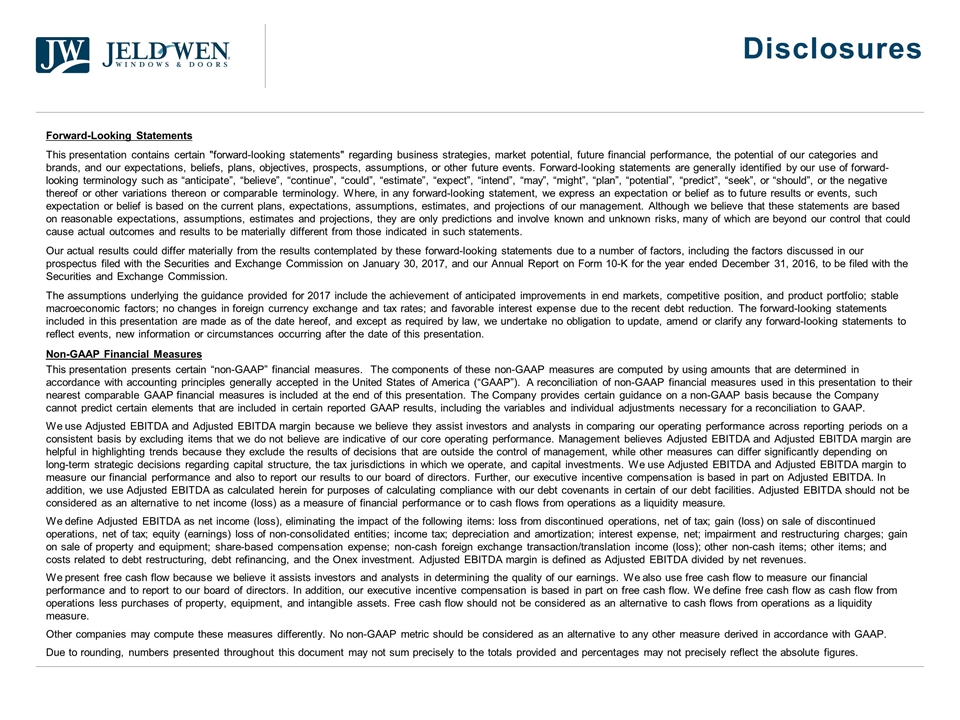
Disclosures Forward-Looking Statements This presentation contains certain "forward-looking statements" regarding business strategies, market potential, future financial performance, the potential of our categories and brands, and our expectations, beliefs, plans, objectives, prospects, assumptions, or other future events. Forward-looking statements are generally identified by our use of forward-looking terminology such as “anticipate”, “believe”, “continue”, “could”, “estimate”, “expect”, “intend”, “may”, “might”, “plan”, “potential”, “predict”, “seek”, or “should”, or the negative thereof or other variations thereon or comparable terminology. Where, in any forward-looking statement, we express an expectation or belief as to future results or events, such expectation or belief is based on the current plans, expectations, assumptions, estimates, and projections of our management. Although we believe that these statements are based on reasonable expectations, assumptions, estimates and projections, they are only predictions and involve known and unknown risks, many of which are beyond our control that could cause actual outcomes and results to be materially different from those indicated in such statements. Our actual results could differ materially from the results contemplated by these forward-looking statements due to a number of factors, including the factors discussed in our prospectus filed with the Securities and Exchange Commission on January 30, 2017, and our Annual Report on Form 10-K for the year ended December 31, 2016, to be filed with the Securities and Exchange Commission. The assumptions underlying the guidance provided for 2017 include the achievement of anticipated improvements in end markets, competitive position, and product portfolio; stable macroeconomic factors; no changes in foreign currency exchange and tax rates; and favorable interest expense due to the recent debt reduction. The forward-looking statements included in this presentation are made as of the date hereof, and except as required by law, we undertake no obligation to update, amend or clarify any forward-looking statements to reflect events, new information or circumstances occurring after the date of this presentation. Non-GAAP Financial Measures This presentation presents certain “non-GAAP” financial measures. The components of these non-GAAP measures are computed by using amounts that are determined in accordance with accounting principles generally accepted in the United States of America (“GAAP”). A reconciliation of non-GAAP financial measures used in this presentation to their nearest comparable GAAP financial measures is included at the end of this presentation. The Company provides certain guidance on a non-GAAP basis because the Company cannot predict certain elements that are included in certain reported GAAP results, including the variables and individual adjustments necessary for a reconciliation to GAAP. We use Adjusted EBITDA and Adjusted EBITDA margin because we believe they assist investors and analysts in comparing our operating performance across reporting periods on a consistent basis by excluding items that we do not believe are indicative of our core operating performance. Management believes Adjusted EBITDA and Adjusted EBITDA margin are helpful in highlighting trends because they exclude the results of decisions that are outside the control of management, while other measures can differ significantly depending on long-term strategic decisions regarding capital structure, the tax jurisdictions in which we operate, and capital investments. We use Adjusted EBITDA and Adjusted EBITDA margin to measure our financial performance and also to report our results to our board of directors. Further, our executive incentive compensation is based in part on Adjusted EBITDA. In addition, we use Adjusted EBITDA as calculated herein for purposes of calculating compliance with our debt covenants in certain of our debt facilities. Adjusted EBITDA should not be considered as an alternative to net income (loss) as a measure of financial performance or to cash flows from operations as a liquidity measure. We define Adjusted EBITDA as net income (loss), eliminating the impact of the following items: loss from discontinued operations, net of tax; gain (loss) on sale of discontinued operations, net of tax; equity (earnings) loss of non-consolidated entities; income tax; depreciation and amortization; interest expense, net; impairment and restructuring charges; gain on sale of property and equipment; share-based compensation expense; non-cash foreign exchange transaction/translation income (loss); other non-cash items; other items; and costs related to debt restructuring, debt refinancing, and the Onex investment. Adjusted EBITDA margin is defined as Adjusted EBITDA divided by net revenues. We present free cash flow because we believe it assists investors and analysts in determining the quality of our earnings. We also use free cash flow to measure our financial performance and to report to our board of directors. In addition, our executive incentive compensation is based in part on free cash flow. We define free cash flow as cash flow from operations less purchases of property, equipment, and intangible assets. Free cash flow should not be considered as an alternative to cash flows from operations as a liquidity measure. Other companies may compute these measures differently. No non-GAAP metric should be considered as an alternative to any other measure derived in accordance with GAAP. Due to rounding, numbers presented throughout this document may not sum precisely to the totals provided and percentages may not precisely reflect the absolute figures.

Introduction Mark Beck, President & CEO
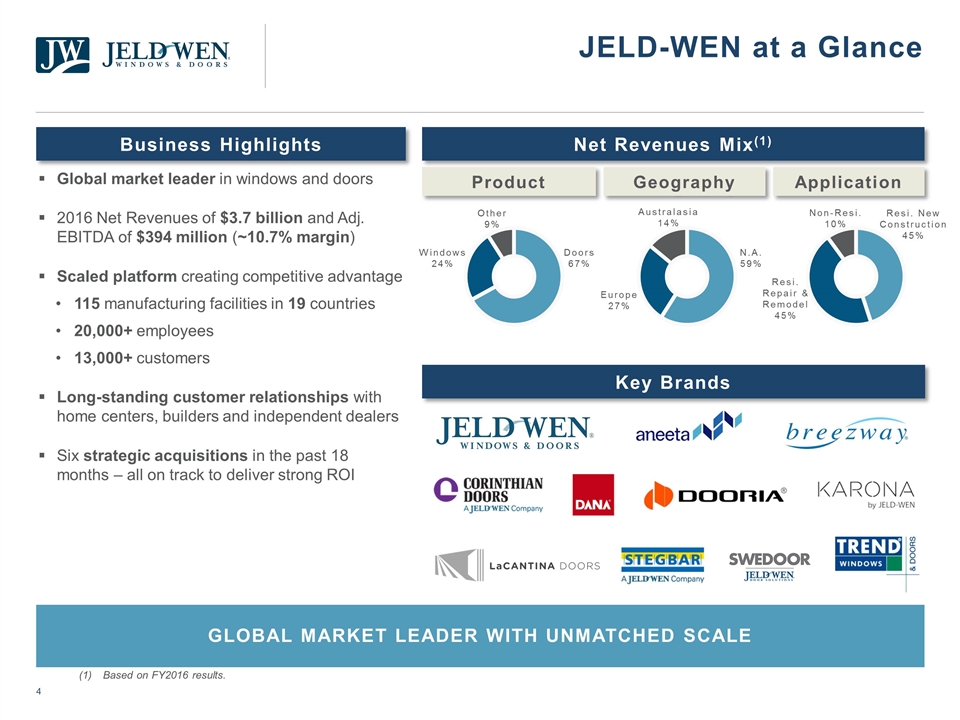
JELD-WEN at a Glance Global market leader in windows and doors 2016 Net Revenues of $3.7 billion and Adj. EBITDA of $394 million (~10.7% margin) Scaled platform creating competitive advantage 115 manufacturing facilities in 19 countries 20,000+ employees 13,000+ customers Long-standing customer relationships with home centers, builders and independent dealers Six strategic acquisitions in the past 18 months – all on track to deliver strong ROI Business Highlights Key Brands Net Revenues Mix(1) Application Product Geography Based on FY2016 results. GLOBAL MARKET LEADER WITH UNMATCHED SCALE Australasia 14% Europe 27% N.A. 59% Non-Resi. 10% Resi. Repair & Remodel 45% Resi. New Construction 45% Other 9% Windows 24% Doors 67%
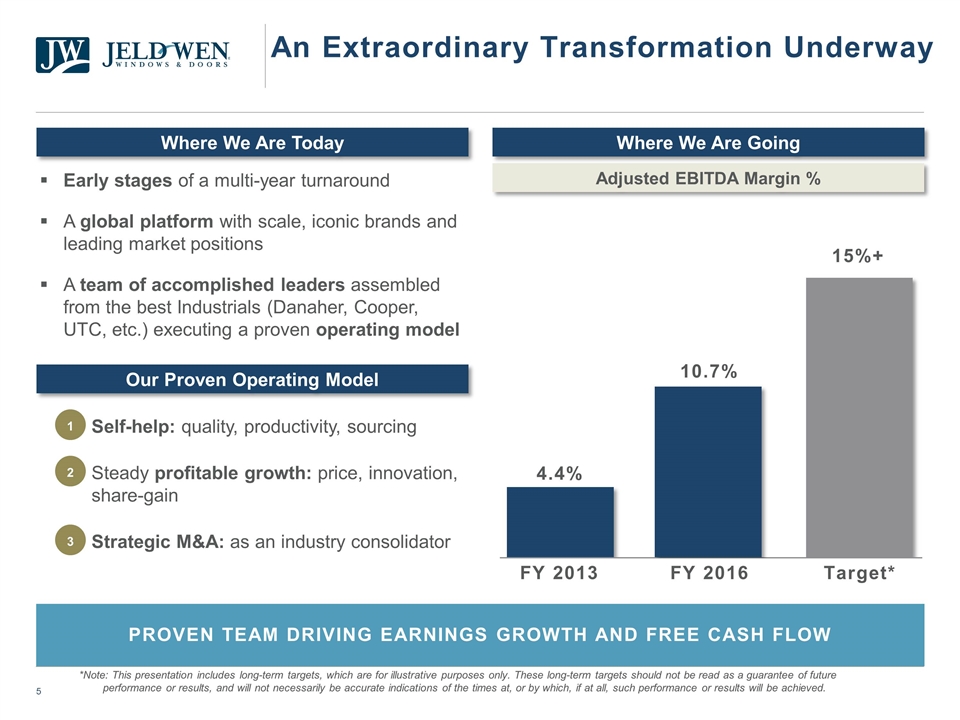
An Extraordinary Transformation Underway PROVEN TEAM DRIVING EARNINGS GROWTH AND FREE CASH FLOW Adjusted EBITDA Margin % Where We Are Today Our Proven Operating Model Early stages of a multi-year turnaround A global platform with scale, iconic brands and leading market positions A team of accomplished leaders assembled from the best Industrials (Danaher, Cooper, UTC, etc.) executing a proven operating model Self-help: quality, productivity, sourcing Steady profitable growth: price, innovation, share-gain Strategic M&A: as an industry consolidator Where We Are Going 1 2 3 4.4% 10.7% 15%+ FY 2013 Target* FY 2016 *Note: This presentation includes long-term targets, which are for illustrative purposes only. These long-term targets should not be read as a guarantee of future performance or results, and will not necessarily be accurate indications of the times at, or by which, if at all, such performance or results will be achieved.

Proven Operating Model Target Identification Target Cultivation Stage Gate Process Integration Playbook Performance Tracking Strategic M&A Operational Excellence Talent Management, JELD-WEN Excellence Model (JEM), and Enabling Technology WORLD-CLASS PERFORMANCE AND RETURNS New Products & Innovation Brand Strategy Channel Management Sales Force Effectiveness Pricing Optimization Profitable Organic Growth Safety & Compliance Quality System Customer Experience Productivity Sourcing
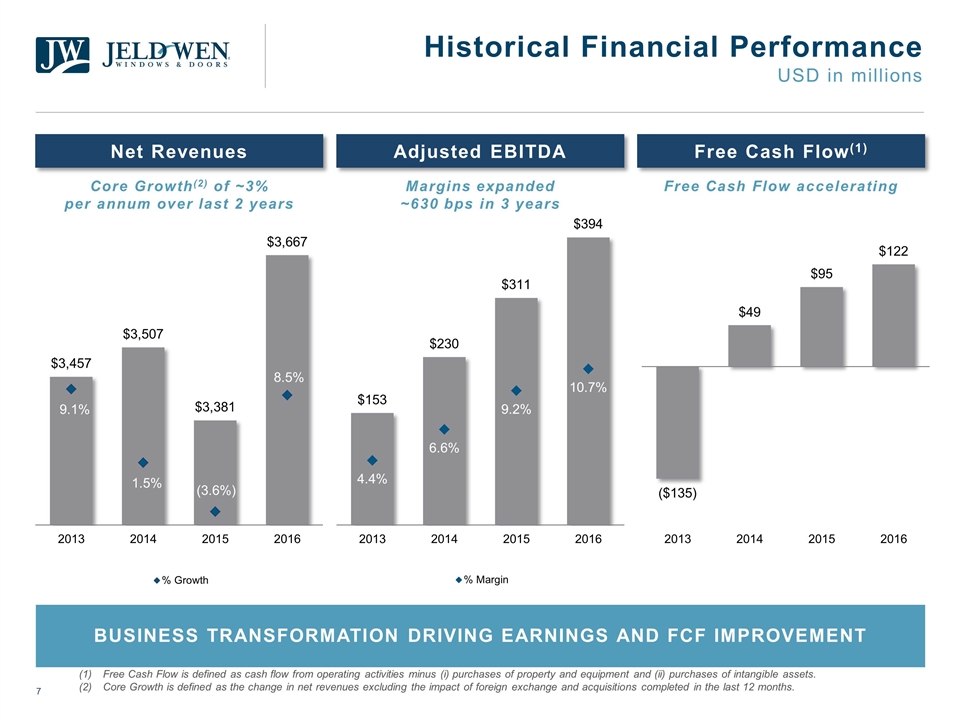
BUSINESS TRANSFORMATION DRIVING EARNINGS AND FCF IMPROVEMENT Net Revenues Free Cash Flow(1) Historical Financial Performance USD in millions Core Growth(2) of ~3% per annum over last 2 years Free Cash Flow accelerating Adjusted EBITDA Margins expanded ~630 bps in 3 years Free Cash Flow is defined as cash flow from operating activities minus (i) purchases of property and equipment and (ii) purchases of intangible assets. Core Growth is defined as the change in net revenues excluding the impact of foreign exchange and acquisitions completed in the last 12 months.
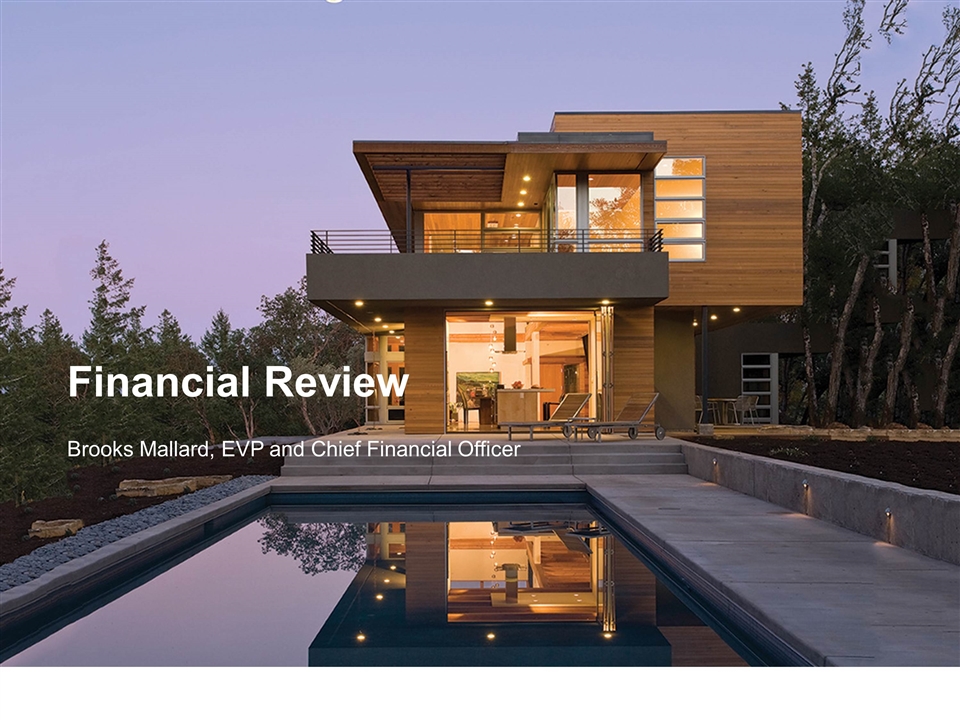
Financial Review Brooks Mallard, EVP and Chief Financial Officer
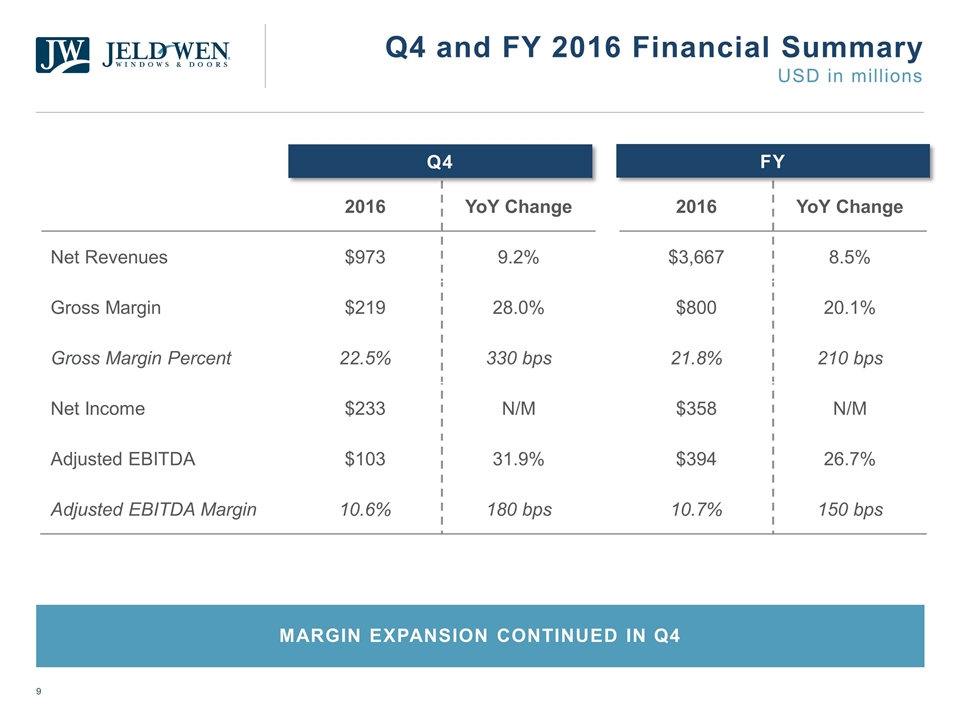
MARGIN EXPANSION CONTINUED IN Q4 2016 YoY Change 2016 YoY Change Net Revenues $973 9.2% $3,667 8.5% Gross Margin $219 28.0% $800 20.1% Gross Margin Percent 22.5% 330 bps 21.8% 210 bps Net Income $233 N/M $358 N/M Adjusted EBITDA $103 31.9% $394 26.7% Adjusted EBITDA Margin 10.6% 180 bps 10.7% 150 bps Q4 and FY 2016 Financial Summary USD in millions Q4 FY
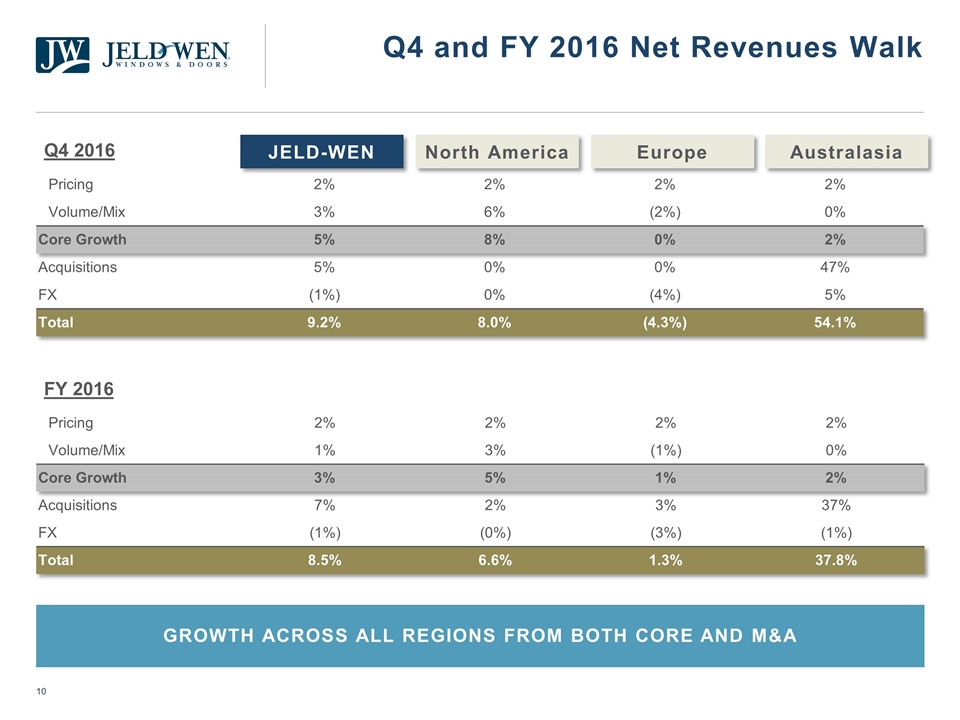
Q4 2016 Pricing 2% 2% 2% 2% Volume/Mix 3% 6% (2%) 0% Core Growth 5% 8% 0% 2% Acquisitions 5% 0% 0% 47% FX (1%) 0% (4%) 5% Total 9.2% 8.0% (4.3%) 54.1% GROWTH ACROSS ALL REGIONS FROM BOTH CORE AND M&A Q4 and FY 2016 Net Revenues Walk JELD-WEN North America Europe Australasia FY 2016 Pricing 2% 2% 2% 2% Volume/Mix 1% 3% (1%) 0% Core Growth 3% 5% 1% 2% Acquisitions 7% 2% 3% 37% FX (1%) (0%) (3%) (1%) Total 8.5% 6.6% 1.3% 37.8%
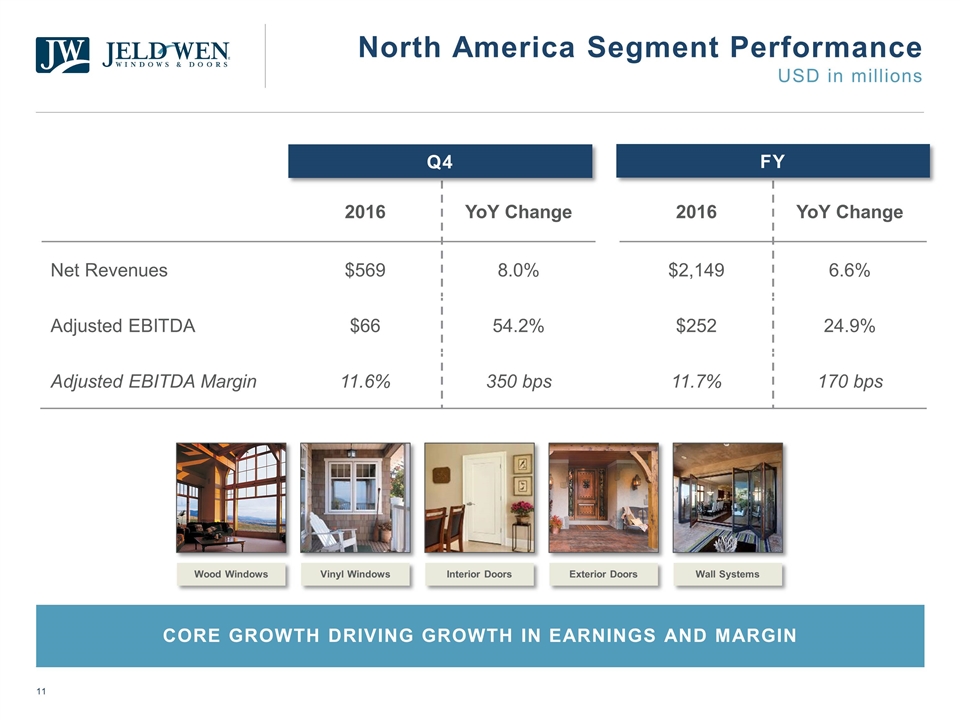
CORE GROWTH DRIVING GROWTH IN EARNINGS AND MARGIN 2016 YoY Change 2016 YoY Change Net Revenues $569 8.0% $2,149 6.6% Adjusted EBITDA $66 54.2% $252 24.9% Adjusted EBITDA Margin 11.6% 350 bps 11.7% 170 bps North America Segment Performance USD in millions Q4 FY Wood Windows Vinyl Windows Interior Doors Exterior Doors Wall Systems
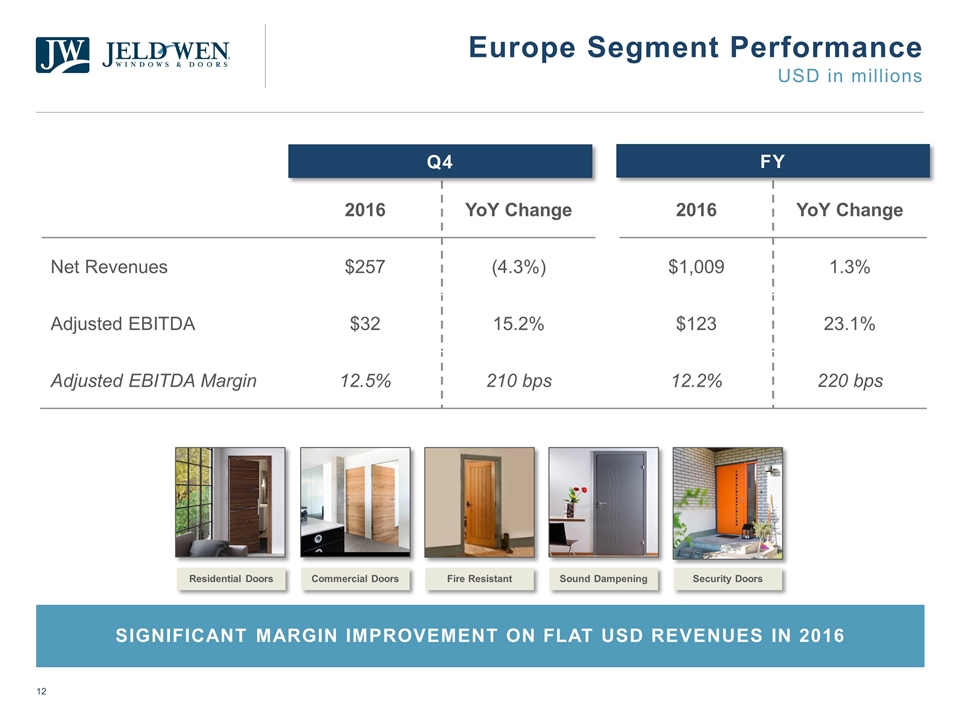
SIGNIFICANT MARGIN IMPROVEMENT ON FLAT USD REVENUES IN 2016 2016 YoY Change 2016 YoY Change Net Revenues $257 (4.3%) $1,009 1.3% Adjusted EBITDA $32 15.2% $123 23.1% Adjusted EBITDA Margin 12.5% 210 bps 12.2% 220 bps Europe Segment Performance USD in millions Q4 FY Residential Doors Commercial Doors Fire Resistant Sound Dampening Security Doors
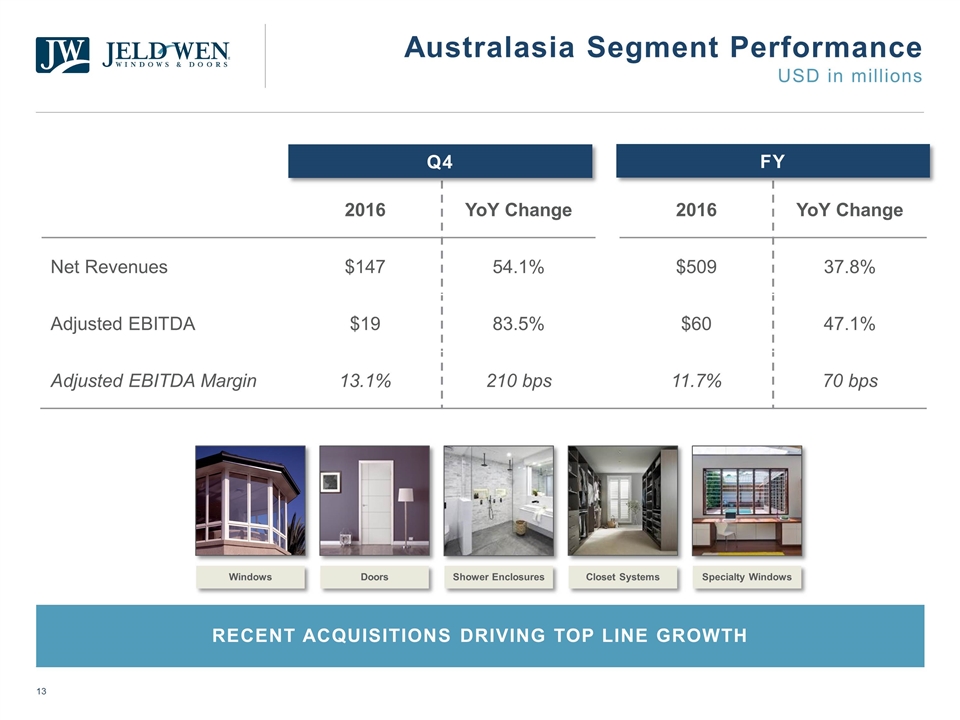
RECENT ACQUISITIONS DRIVING TOP LINE GROWTH 2016 YoY Change 2016 YoY Change Net Revenues $147 54.1% $509 37.8% Adjusted EBITDA $19 83.5% $60 47.1% Adjusted EBITDA Margin 13.1% 210 bps 11.7% 70 bps Australasia Segment Performance USD in millions Q4 FY Windows Doors Shower Enclosures Closet Systems Specialty Windows
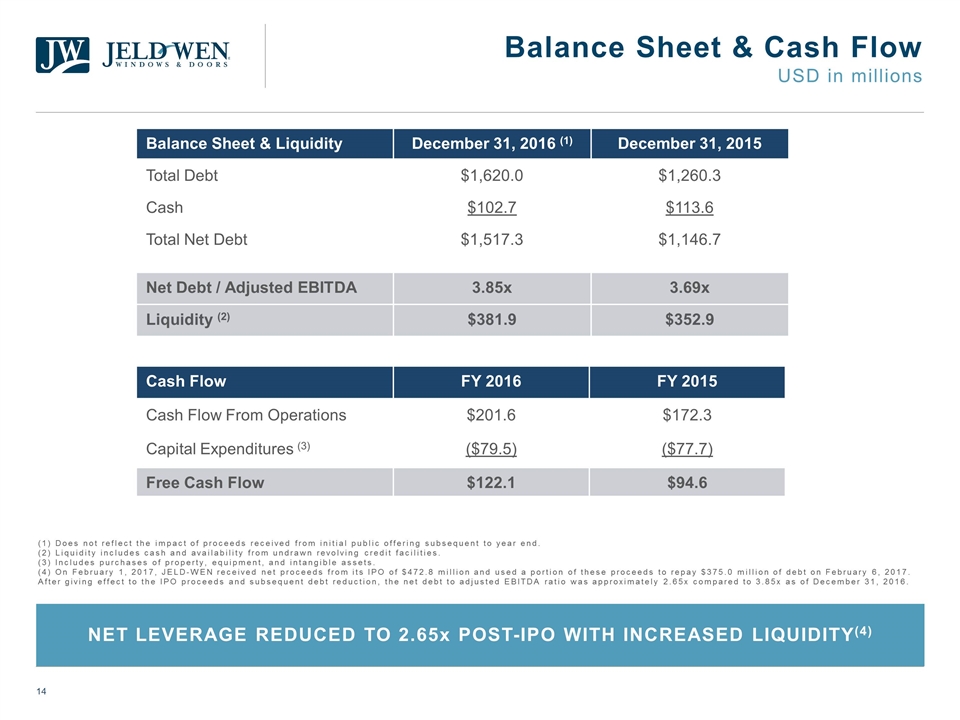
Balance Sheet & Cash Flow USD in millions NET LEVERAGE REDUCED TO 2.65x POST-IPO WITH INCREASED LIQUIDITY(4) Balance Sheet & Liquidity December 31, 2016 (1) December 31, 2015 Total Debt $1,620.0 $1,260.3 Cash $102.7 $113.6 Total Net Debt $1,517.3 $1,146.7 Net Debt / Adjusted EBITDA 3.85x 3.69x Liquidity (2) $381.9 $352.9 Cash Flow FY 2016 FY 2015 Cash Flow From Operations $201.6 $172.3 Capital Expenditures (3) ($79.5) ($77.7) Free Cash Flow $122.1 $94.6 (1) Does not reflect the impact of proceeds received from initial public offering subsequent to year end. (2) Liquidity includes cash and availability from undrawn revolving credit facilities. (3) Includes purchases of property, equipment, and intangible assets. (4) On February 1, 2017, JELD-WEN received net proceeds from its IPO of $472.8 million and used a portion of these proceeds to repay $375.0 million of debt on February 6, 2017. After giving effect to the IPO proceeds and subsequent debt reduction, the net debt to adjusted EBITDA ratio was approximately 2.65x compared to 3.85x as of December 31, 2016.
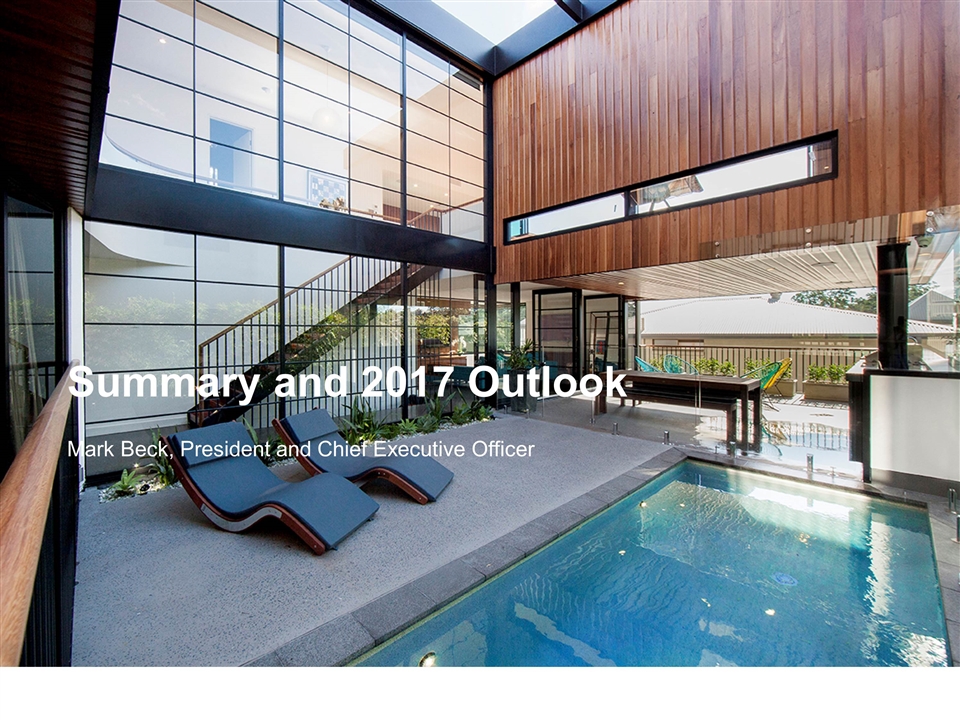
Summary and 2017 Outlook Mark Beck, President and Chief Executive Officer
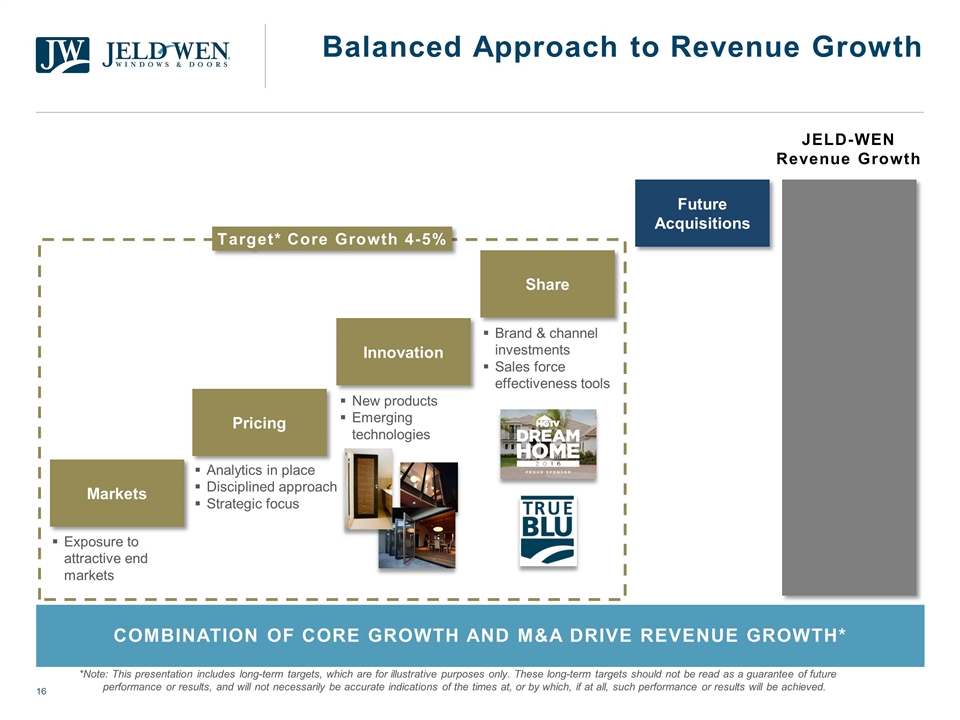
Balanced Approach to Revenue Growth COMBINATION OF CORE GROWTH AND M&A DRIVE REVENUE GROWTH* Future Acquisitions Markets Pricing Innovation Share Exposure to attractive end markets Analytics in place Disciplined approach Strategic focus New products Emerging technologies Brand & channel investments Sales force effectiveness tools Target* Core Growth 4-5% JELD-WEN Revenue Growth *Note: This presentation includes long-term targets, which are for illustrative purposes only. These long-term targets should not be read as a guarantee of future performance or results, and will not necessarily be accurate indications of the times at, or by which, if at all, such performance or results will be achieved.
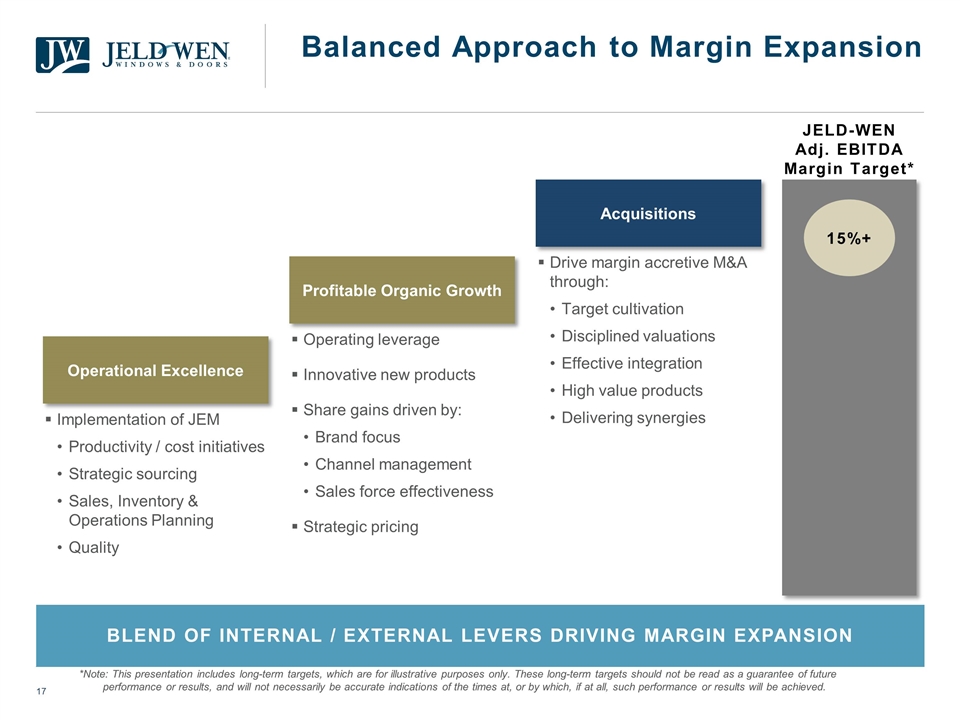
Balanced Approach to Margin Expansion BLEND OF INTERNAL / EXTERNAL LEVERS DRIVING MARGIN EXPANSION Acquisitions 15%+ JELD-WEN Adj. EBITDA Margin Target* Profitable Organic Growth Operational Excellence Implementation of JEM Productivity / cost initiatives Strategic sourcing Sales, Inventory & Operations Planning Quality Operating leverage Innovative new products Share gains driven by: Brand focus Channel management Sales force effectiveness Strategic pricing Drive margin accretive M&A through: Target cultivation Disciplined valuations Effective integration High value products Delivering synergies *Note: This presentation includes long-term targets, which are for illustrative purposes only. These long-term targets should not be read as a guarantee of future performance or results, and will not necessarily be accurate indications of the times at, or by which, if at all, such performance or results will be achieved.
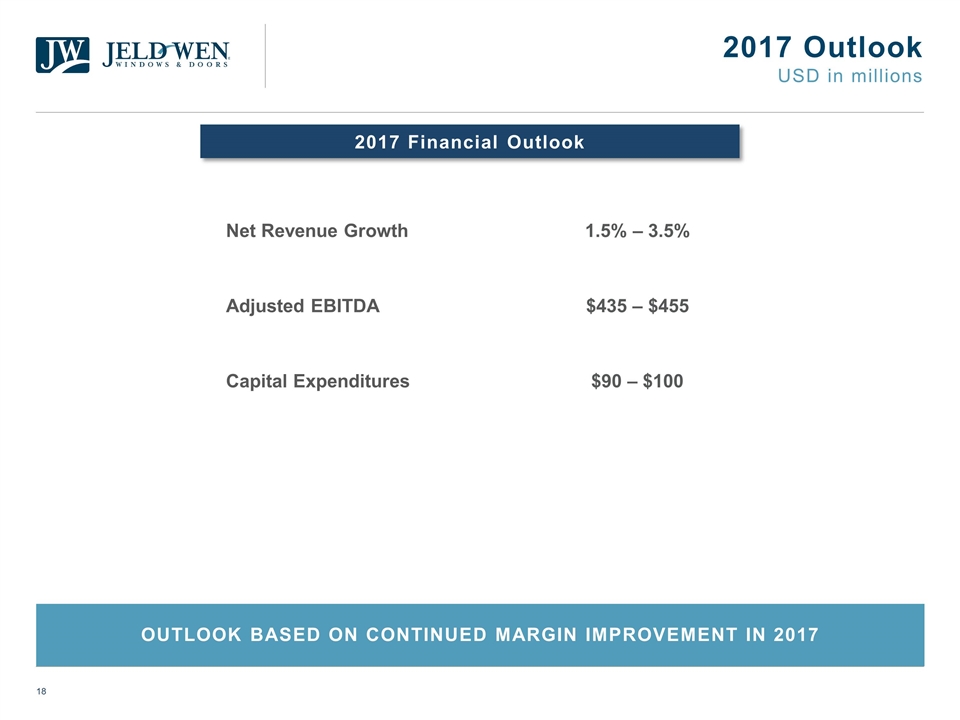
2017 Outlook USD in millions OUTLOOK BASED ON CONTINUED MARGIN IMPROVEMENT IN 2017 2017 Financial Outlook Net Revenue Growth 1.5% – 3.5% Adjusted EBITDA $435 – $455 Capital Expenditures $90 – $100

Appendix

Adjusted EBITDA Reconciliation USD in millions NOTE: Refer to our 10-K filing for more detailed description of these footnotes.
